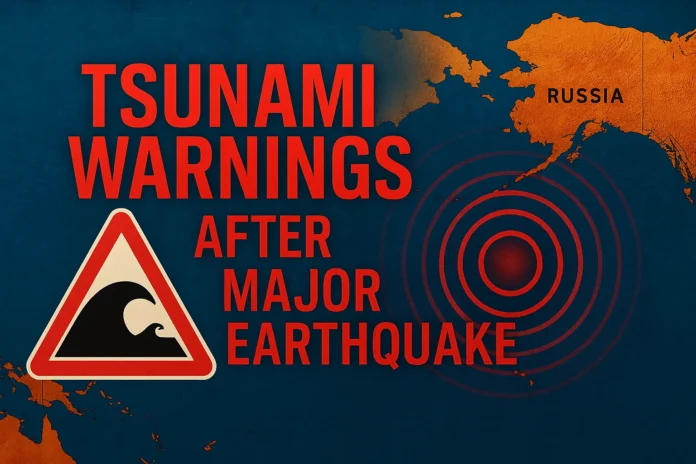8.8 Magnitude Earthquake in Russia: Introduction
On July 30, 2025, a powerful 8.8 magnitude earthquake struck beneath the Pacific Ocean, approximately 119 kilometers east-southeast of Petropavlovsk-Kamchatsky, Russia. The quake, shallow at a depth of around 20 kilometers, ranks among the top 10 strongest ever recorded globally and marks the most significant seismic event in the Kamchatka region since 1952.
Kamchatka and Kurils: Earth Tremors and Volcanic Unrest
Waves as high as six meters flooded coastal districts in Severo-Kurilsk, Russia, causing severe power outages, infrastructure damage, and home flooding. Authorities declared a state of emergency. Fortunately, only minor injuries have been reported.
Adding to the crisis, the quake triggered visible lava flow from the Klyuchevskoy volcano—Russia’s tallest and most active. Though not directly impacted by the earthquake, the volcano’s increased activity has prompted heightened geological monitoring. Aftershocks as strong as magnitude 6.9 have already followed, and Russian emergency services have warned that tremors as high as 7.5 are still possible in the coming days.
Pacific Nations React: From Evacuations to Relief
Japan
\Authorities in Japan initially issued tsunami warnings covering the Pacific coastline, prompting the evacuation of nearly two million residents. Regions like Hokkaido and Fukushima braced for the worst. Thankfully, no serious damage or injuries were sustained, and the waves stayed below 1.3 meters. Nuclear facilities, including the Fukushima Daiichi plant, reported no irregularities. All alerts have since been downgraded to advisories.
Hawaii and the US West Coast
Hawaii witnessed tsunami waves as high as 1.8 meters, prompting thousands to evacuate and airports to halt operations. Cruise ships relocated to deeper waters as a precaution. Along the California coast, places like Crescent City and San Francisco experienced surges between two and five feet. Later in the day, though, all advisories were canceled because no significant damage was observed.
South America: High Alert Maintained
The Interior Ministry of Chile has elevated the threat of tsunamis to the highest level of alert. Classes were halted and evacuations were started throughout the coastal zones. In some regions, waves reached up to 2.5 meters. Ecuador, Colombia, and Peru also responded with beach evacuations and maritime restrictions. Peru lifted its warning shortly after wave measurements turned out lower than anticipated.
Pacific Islands
Nations such as French Polynesia, Fiji, Samoa, Tonga, Micronesia, and the Solomon Islands issued precautionary coastal advisories. Fortunately, waves were significantly smaller than predicted, and no major evacuations occurred.
Why the Tsunami Was Smaller Than Feared
Although the earthquake’s magnitude suggested catastrophic waves, the resulting tsunami was less severe than expected. Experts attribute this to the fault’s rupture direction and energy dispersion. These geological nuances helped mitigate tsunami intensity across far-flung shores.
Summary Table
| Region | Alert Level | Tsunami Impact | Key Notes |
| Russia (Kamchatka & Kurils) | Emergency Active | 3–6 m waves, flooding, power outages | Minor injuries; volcano active |
| Japan | Downgraded to Advisory | 1–1.3 m waves | No injuries; nuclear plants unaffected |
| Hawaii & US West Coast | Advisories Lifted | 1–2 m waves; 2–5 ft surges | Cruise ship diversions; minimal damage |
| Chile, Ecuador, Colombia | High Alert or Advisories | Up to 2.5 m | Widespread evacuations, coastlines monitored |
| Pacific Islands | Advisories Issued | Minimal to no wave impact | No major disruptions |
What’s Next?
Aftershocks are expected to continue in the Kamchatka region. Damage assessments in remote coastal communities may take days. Authorities are also closely monitoring Klyuchevskoy volcano for signs of intensified activity. While no fatalities have occurred, emergency preparedness remains high throughout the Pacific basin.
The erratic character of the Pacific “Ring of Fire,” where volcanic and seismic activity are intimately linked, is brought home by this incident. Timely warnings, robust evacuation systems, and international coordination were crucial in mitigating what could have been a far greater disaster.


